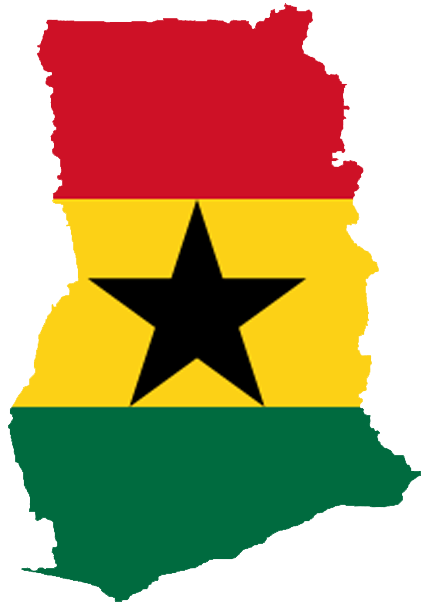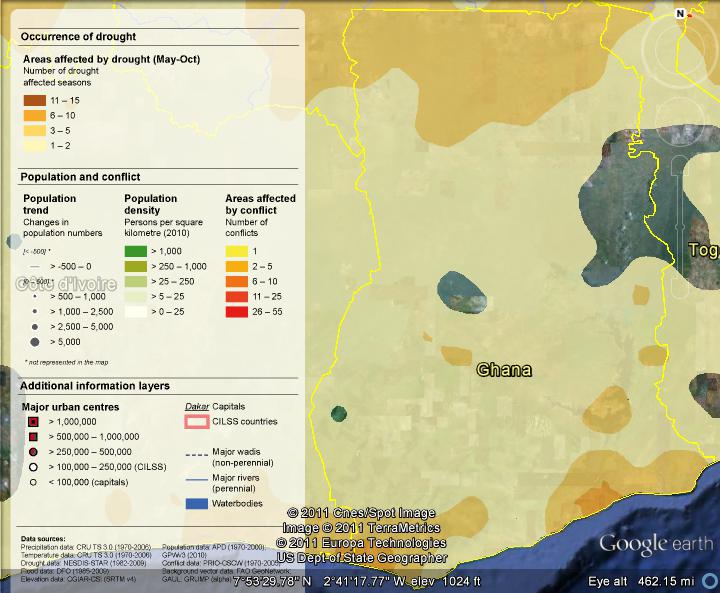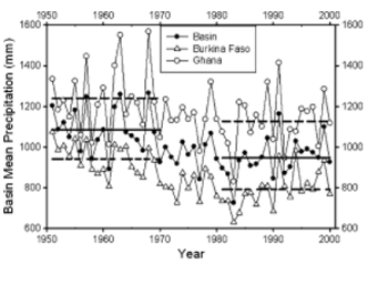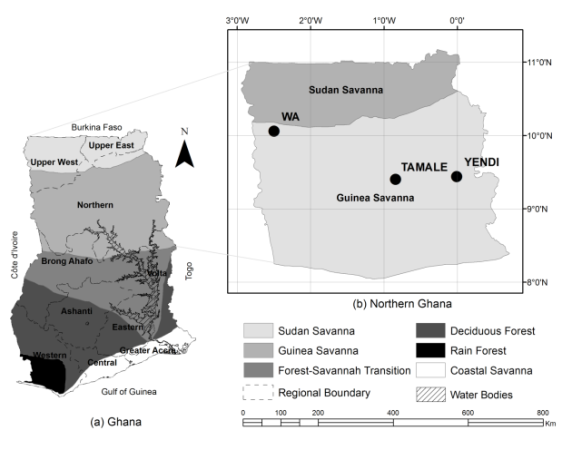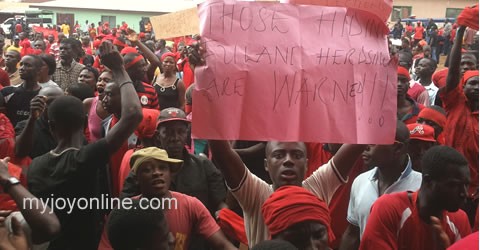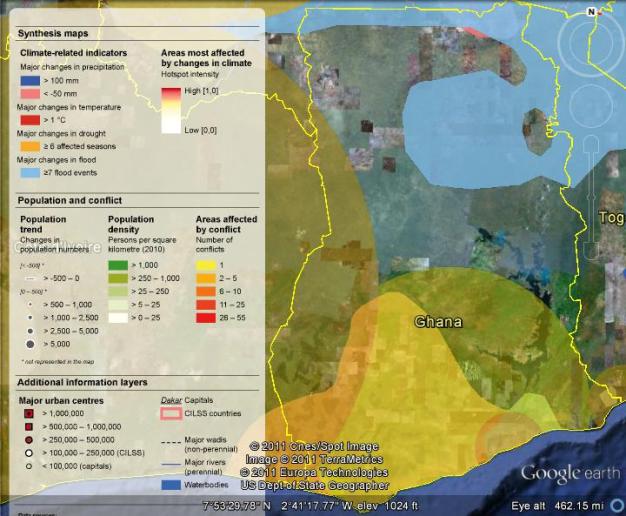I. CASE BACKGROUND
1. Abstract
Fulani herdsmen are highly dependent on the land and water resources available to them and their cattle. Climate change is limiting the herders€™ options for viable spaces to maintain their herder livelihoods. Nomadic pastoralists who mostly resided in the semi- arid and arid zones of West have been forced to abandon their traditional temporary transhumance routes between wet and dry seasons.
Climate change reduced the reliability of the wet and dry season migration patterns and migration southward has been steadily increasing since the droughts of 1960s and 1970s. This case study will analyze two main phases of Fulani herdsmen migration and the correlating migrant destination regions in Ghana (Northern and Middle Volta Basin). This analysis will highlight the factors of increased competition for resources in the regions and violent conflict that has consequently ensued.
2. Description
History of the Fulani in Ghana
Map of Ghana showing migration flows to the southern destinations
Source: (Lobnibe, 12)
1st Migration Phase of Fulani Herdsmen in Ghana 1960s-1970s* (Upper Regions): The semi- arid Sahel region of
West Africa was once the primary home base for the nomad Fulani. These semi- arid conditions were not most conducive to farming which allowed Fulani pastoralist little interference and competition in the lands of Sahel. Herdsmen would only venture south temporarily during the dry season obeying pastoral routes and using only land that had been designated for them by their Southern neighbors. Climate Change has destroyed this peaceful system of shared land use between farmers and migrant pastoralist.
The Sahel region has been ravaged with extreme drought periods and continues to suffer from unrelenting desertification and unpredictable rainfall patterns.
These climate change disasters/ shifts have resulted in a significant decrease in viable grazing land and water sources in the Sahel to support the herds and the livelihoods of the Fulani. In the past couple of decades, Fulani herders from Mali, Burkina Faso and Niger have been forced to move south into countries such as Ghana, Nigeria and Cote d€™Ivoire. This marks the first transition period of the Fulani migration into Ghana. Not until recently, Northern Farmers have decided to direct the frustration caused by consequences of climate change on their Fulani neighbors. Fulani herdsmen and farmers in the North are now enduring fatal clashes over land and crop issues.
2nd Migration Phase of Fulani Herdsman in Ghana 1990- Present(Middle Volta Basin): As desertification from the
Northern border countries continues to creep southward and erratic rainfall patterns persist, the once fertile and abundant lands of the Uppermost Ghanaian regions are beginning to suffer the same fate as the countries of the Sahel. The effects of climate Change in Northern Ghana have escalated Fulani and Farmer tension on two levels. Clashes and climate change in the North has initiated the second phase of Fulani migration in Ghana. Fulani herdsmen are migrating further south to flee conflict in the North and in search of abundant pastures and water sources to sustain their herds.
Between 1984 and 2000 there was an increase of more than five hundred thousand people from the North moving Southward with over a third of these migrants coming directly from the Upper regions of Ghana. (van der Geest, e74). Northern Fulani herdsmen who once migrated south seasonally are permanently relocating to the Middle Volta Basin, which encompasses the southern portions of the North, Brong Ahafo and Ashanti regions. Increased competition has caused conflict and resistance in these locations as well.
*Dates signify the most significant concentration of Fulani Herdsmen migration into the upper regions of Ghana. Migration from Sahel countries continues today.
3. Duration
Ongoing (See Conflict section for Significant clashes): Originally Fulani Herder migration to Ghana from drying nations of the Sahel such as Chad, Nigeria, Burkina Faso and Niger began in the 1950s. One of the first news reports of potential Fulani- farmer warring was in 2001 and threats of full-scale attacks on one or the other party have remained active until now. There has yet to be any concentrated highly volatile conflicts between the groups of herdsmen and farmers, therefore no definitive time period of climate change violence is referenced in the history of these conflicts. The chronic low level conflict between intra-migrant Fulani and native farmers has been consistent throughout the two transition periods of migration and continues today.
You may be on your farm and suddenly realize that herd of cattle has invaded your farm and destroyed everything on sight but if you dare raise concern about the destruction, you are either shot dead or wounded by herdsmen controlling the cattle a resident told DAILY GUIDE. (seeThe Untold Story Of The Agogo-Fulani Herdsmen Fracas, peacefmonline.com) To read more information on Fulani history in Agogo (http://news.peacefmonline.com/features/201112/84077.php)
4. Location
Continent: Africa
Country: Ghana
Region(s): Upper and Northern; Middle Volta Basin
5. Actors
Government: Government has been enlisted for expulsion of Fulani, development of migrant identification tactics, and prosecution of Fulani commented alleged atrocious crimes
Native Farmers: Native farmers who are resentful of the threat and destruction that migrant Fulani Herdsmen pose to livelihoods and crop success
Fulani Herdsmen: Nomadic migrants from the Sahel countries north of Ghana who have migrated into Northern and Middle regions of Ghana for access to abundant pastures and consistent water sources
Ghanaian Village Chiefs: Responsible for making controversial farm land grant agreements with Fulani herdsmen; First level of authority who has the jurisdiction to expel Fulani migrants from villages and cities
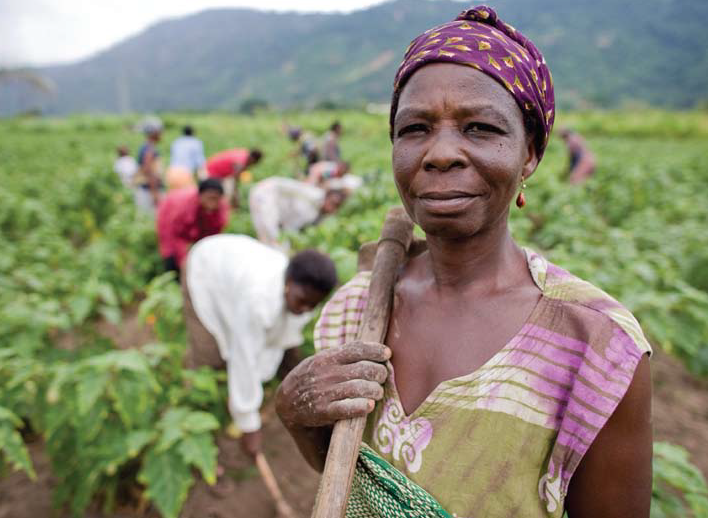 |
|
Government and State Officials Source: TelevisionAfrica |
Native Farmers Source: GEO-3: Global Environment Outlook |
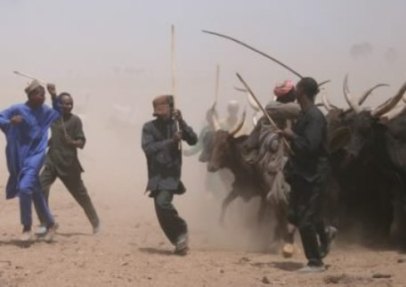 |
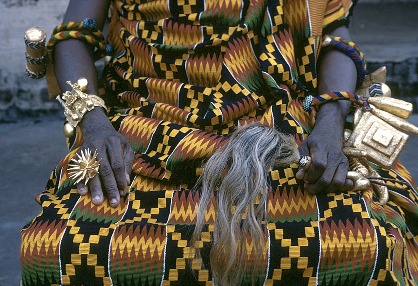 |
Fulani Herdsmen Source: BrettInNiger |
Ghanian Cheifs (traditional authorities) Source:The Ghanaian Journal |
II. Environment Aspects
6. Type of Environmental Problem
Land Degradation
Land degradation is caused by agricultural and pastoral practices. Farmers, both commercial and sustenance, use brush burning as a method to clear land for crops. The United Nations Convention to Combat Desertification reports that about 22,000 hectares of forestland are lost every year through intentional brushfires. Nutrients that encourage healthy crop growth and natural pasture development have been destroyed by these brushfires, rendering land useless. Brushfires alone can be detrimental to the livelihoods of 85% of the nearly 4 million people in the Upper regions of Ghana who are engaged in small-scale agriculture (Riemer, 2).Deforestation is also a major factor in land degradation and desertification. Between 1990 and 2010, Ghana lost an average of 125,400 ha or 1.68% per year. In total, between 1990 and 2010, Ghana lost 33.7% of its forest cover or around 2,508,000 ha (mongabay.com). Reduction in tree cover leaves the land vulnerable to further runoff and/or wind pollution by denying the soil the stability of tree roots. Growing populations and modernization has increased the demand for fuel wood and timber construction materials.
Desertification- Climate Change and the threat of desertification is a reality for Northern Ghana. It is estimated that 35% of the land area of Ghana (primarily in the Upper East and West Regions) will be lost to desertification. These predictions have doubled in recent years and will continue to grow with the quickly changing trajectory of climate change. In an interview reporting on the state of Ghanaian land and desertification in the North, Northern Regional Director of Environmental Protection Agency states that desertification is moving southward at a rate of 0.8 kilometers per annum and that the minimum vegetation cover is below 5% of land that support ecological life (Npong, 2011).
Cattle Damage to the Land- The Upper East Region is responsible for 25% of Ghana's cattle herd and is suffering from the effects of overgrazing and cattle compacting of the land. Cattle are being restricted to smaller grazing areas which increases complete depletion of that area's soil nutrients. Additionally, the system of alternating between cattle grazing and crop growth during seasons has been eradicated by commercial farming of dry season crops year round and the overall decrease of arable land in the Northern regions. The alternating approach allowed lands to be fertilized and rejuvenated by herds' waste. Instead lands are overgrazed and compacted year round and unsuitable for use after a couple of years.
Source: USGS Land Cover Applications and Global Change .
Source: Google Earth UNEP Livelihood Security Report (KML Layer)
.
Unpredictable Rainfall
With the increased unpredictability of rainfall, Ghana is likely to experience flooding and decreased average rainfall. Floods and droughts contribute to a degraded quality of the land by either washing away or drying up viable pastures and cropland. Northern Ghanaians have little access to irrigated systems.Dry Periods- The dependable 5 month rainy season that Northern populations are accustomed to has now decreased to a 2-3 month rainy season in Ghana. Ghana will experience a general reduction in annual river flows by 15-20 % for the year 2020, a 30-40 % for the year 2050, a reduction in groundwater recharge of 5-22 % for 2020 and 30-40% for 2050 (Kankam-Yeboah et. Al, 67).
Source: "Changing rainfall inputs in the Volta basin: implications for water sharing in Ghana" Flooding- Rainfall has not only been sporadic, when it arrives, the magnanimity of rainfall has been equally as unpredictable and destructive as the absence of it. 2007 and 2010 witnessed tragic floods that cost the region millions of dollars in aid, crop and developmental damage. Global Times reports National Disaster Management Organization (NDMO) estimates at 33, 305 displaced (affecting 8,811 households), 26,822 acres of farmland 1, 109 were casualties of the flood.
Water Shortages and Clean Drinking Water Availability- Much of Ghana's waterways are fed by Lake Volta, which is thelargest man made lake in the world. Lake Volta and its tributaries are dependent on normal rainfall patterns to replenish its water reserves. Dramatic precipitation events have drastically decreased the water levels in Lake Volta and the water bodies it feeds. The Northern regions of the Volta Basin have suffered from seasonal drying of rivers and streams due to unpredictable rainfall, which has affected livelihoods, and environmental well being. NDMO statistics also reported that floods in Northern Ghana due to climate change destroyed or contaminated 630 drinking water facilities. Clean drinking is an environmental strain on populations especially in Ghana where the people and cattle face the threat of contracting guinea worm disease from unsanitary drinking water sources.
.
7. Type of Habitat
- Shrub lands, savanna, and grassland
- Cropland and crop/ natural vegetation mosaic
- Wetlands and water bodies
Source: Journal of Agricultural Science Vol.2 No.3 .
8. Act and Harm Sites:
- Upper East and West Regions
- Upper Northern Region
- Middle Volta Basin
III. Conflict Aspects
9. Type of Conflict: Civil Conflict
Additional Antagonizing Factors: Chieftaincy and Land Right Struggles
10. Level of Conflict: Low
11. Fatality Level of Dispute: 50+
IV. Environment and Conflict Overlap
12. Environment-Conflict Link and Dynamics:
Climate Induced Migration and Conflicts for Resources
Ghanaian demonstration against Fulani Herdsmen. Agogo, Ghana Source: myjoyonline.com
Northern Ghanaians are experiencing the intense climatic shifts of climate change, which is forcing agriculturalist and pastoralist alike to adapt their lifestyles. Unpredictable climate patterns and unsustainable practices have made the northern environment a fragile state. Farmers are seeing severe declines in their crop yield. In both countries Fulani herdsmen who depend on the wet season of the North to sustain their herds are losing cattle to starvation and dehydration. Strong dependence on the land and its resources for survival, high poverty levels, and the lack of knowledge and fiscal resources to adapt are compounded by climate change consequences. When faced with such sinister scenarios, competition for diminishing resources has ultimately led to civil conflicts.
Northern Ghanaian Conflict (December 2011) - One of the highest documented death totals of Fulani Farmer conflicts in Ghana took place in an early December night raid of a Fulani village in Zamashegu, a farming community in the Gushegu district of the Northern region. Native farmers retaliated against alleged atrocities committed by the Fulani. Thirty people are reported dead and several injured.
.
Source: Google Earth UNEP Livelihood Security Report (KML Layer) .
Those who do not choose to struggle over diminishing land and water resource in the North are migrating southward to Middle Volta Basin. The link between climate change and people movement has been recognized as one of the largest impacts of this environmental phenomenon. In an article about €œGhana€™s environmental refugees€, Knight presents a daunting International Organization for Migration statistic. This statistic predicts that the 2050 migration flow (due to climate change) is estimated somewhere around 200-250 million migrants. Climate predictions for Ghana and surrounding West African countries are a 1-2C temperature rise and a ten percent decrease in rainfall (Knight). Places like Northern Ghanaian regions are identified as the paradigm for outward migration.
Middle Volta Ghanaian Conflict (Jan- October 2011) - The citizens of Agogo, a city located in the Ashanti Region insisted on the expulsion of Fulani Herdsman from their city. The resettlement of Fulani herdsmen in the central Ghanaian states has been the source of ongoing civil conflict dating back to 1999 when the government made its first attempt to expel all Fulani from the region. The most recent conflict is taking place in Agogo. Fulani Herdsmen were accused of rape, murders and brutalization of farmers who resisted the dominance/ destruction of crop land. Young native farmers killed an unidentified number of Fulani in their aggravation with the states lack of response to Fulani expulsion pleas.
.
Avoiding Further Conflict: Lessons from the Fulani- Farmer Wars of Nigeria
In assessing the recent conflicts of Ghanaian migrant Fulani herdsmen and native faremers, it is important to learn from the brutal Fulani- farmer conflicts of Nigeria. Similar to climate change and migration scenario in Ghana, the Northern and Middle belts of Nigeria are also experiencing influxes of Fulani Herdsmen settling in these districts due to similar climate change push factors as Ghana. The middle belt states of Nigeria have witnessed mass killings on numerous occasions that can be traced to land clashes between migrant Fulani herders and resentful indigenous agriculturalists. This central region is the melting pot for ethnic cohabitation and the breeding ground for inter- ethnic clashes. With very similar scenarios of climate induced conflict, Ghana must take sufficient action to avoid the outcomes of their Nigerian neighbor.
Fulani- farmer Wars in Nigeria (2002- Present): Nigerian Fulani- Farmer conflicts are a prime example of religious divides aggravating land tensions. Islamic and Christian extremist have been blamed for the conflicts in the Plateau states. Small disputes over land and cattle have escalated into full massacres because of strong religious divides in central Nigeria. Democratization of Nigeria is said to be one of the causes of radical identification with Islam or Christianity. Two instances of Fulani herdsmen and farmer conflict have been directly linked to religious wars that spiraled out of control from land disputes.
The predominantly Christian Tarok farmers consider the mostly Muslim Hausa cattle herders as outsiders, and accuse them of stealing land and trying to usurp political power. This led to more than 1,000 people being killed in sectarian clashes between Christians and Muslims in Jos, the Plateau State capital, in September 2001. In April of 2004 Hausa Fulani killed nearly 100 people in clashes between rival ethnic militias in central Plateau State. This was because of a dispute over use of an area of land designated for cultivation by the agrarian Tarok and for grazing by the nomadic Fulani. The Nigerian clashes have never been addressed sufficiently and countless murders continue to this day. The most recent clash in Benue Nasarawa left 79 dead and nearly 5000 displaced (allafrica.com, €œ79 as Fulani, Tiv clash again€).
Nigeria has also had ongoing conflicts that have erupted into large-scale fatal conflicts. The availability of arms and intense ethno- religious tensions exacerbated the resource competition issues that resulted from Fulani herdsmen migration to the central belt. It is estimated that nearly 10, 000 people have been killed in the Plateau states since fighting first erupted in 2002.
 |
13. Level of Strategic Interest: Regional
14. Outcome of Dispute:
As of December 2011, Chiefs have ordered the Fulani herdsmen out of the Agogo area but local groups have reported that herdsmen have not moved. Small conflicts throughout Brong Ahafo and the Northern regions persist and have not received any significant amount of attention from the government.
Ghanaian Governmental Action to Resolve Conflicts
Parliament has set up a 13-member committee to investigate the causes and potential for further conflict between Fulani migrants and native farmers. The committees' duties are:
- Investigate allegations of misconduct including criminal acts by herdsmen in Dwerebease, Agogo, and Afram Plains generally and other parts of the country ("Parliament probes Fulani mayhem" modernghana.com).
- Investigate the ethnic background of the herdsmen and inquire about how they enter the country, the effect of their activities on human life, property and the environment ("Parliament probes Fulani mayhem" modernghana.com).
- Make recommendations to forestall future occurrence of such incidents, and any other recommendations that it may deem appropriate. ("Parliament probes Fulani mayhem" modernghana.com)
V. Related Information and Sources
15. Related ICE and TED Cases
No. 151 TUAREG Tuaregs and Civil Conflict in West Africa
No. 3 SUDAN Civil War in the Sudan: Resources or Religion?
No. 23 RWANDA Rwanda and Conflict
No. 27 NIGER Fulani and Zarma tribes pushed into fights by Desertification?
No. 22 ELSALV El Salvador Civil War
No. 126 ZIMBABWE Zimbabwe Land Conflict
16. Relevant Websites and Literature
References
Afolayan, Adejumoke. Migration in Nigeria: a Country Profile 2009. Geneva: International Organization for Migration, 2009.
Barbier, Edward B. "The Economic Linkages between Rural Poverty and Land Degradation: Some Evidence from Africa." Agriculture, Ecosystems and Environment 32 (2000): 355-70.
Blench, Robert, and Mallam Dendo. "THE TRANSFORMATION OF CONFLICT BETWEEN PASTORALISTS AND CULTIVATORS IN NIGERIA." Journal Africa (2003). Web. 15 Nov. 2011. <http://www.rogerblench.info/Conflict/Herder-farmer%20conflict%20in%20Nigeria.pdf>.
Handley, Meg. "Nigeria Massacre: Violence Over Religion, Poverty in Jos - TIME." Breaking News, Analysis, Politics, Blogs, News Photos, Video, Tech Reviews - TIME.com. TIME World, 10 Mar. 2010. Web. 29 Oct. 2011. <http://www.time.com/time/world/article/0,8599,1971010,00.html>.
"Nigeria Christian / Muslim Conflict." GlobalSecurity.org - Reliable Security Information. Web. 1 Dec. 2011. <http://www.globalsecurity.org/military/world/war/nigeria-1.htm>.
Npong, Francis. "Desert March Threatens to Swallow Northern Ghana." Web log post. Ghana Web. 14 Jan. 2011. Web. 12 Nov. 2011. <http://www.ghanaweb.com/GhanaHomePage/blogs/blog.php?blog=3655>.
Oppong, Yaa P. A. Moving through and Passing On: Fulani Mobility, Survival, and Identity in Ghana. New Brunswick (N.J.): Transaction, 2002. Print.
Oppong-Ansah, Albert. "Northern Ghana Hit by Climate Change." Global Times. 27 Nov. 2011. Web. 1 Dec. 2011. <http://www.globaltimes.cn/NEWS/tabid/99/ID/686095/Northern-Ghana-hit-by-climate-change.aspx>.
"Overview of Drought and Desertification Situation in Africa." Http://www.uneca.org/. United Nations Economic and Social Counsel, 22-25 Oct. 2007. Web. 16 Oct. 2011. <http://www.uneca.org/csd/csd5/ACSD5-SummaryReportonDrought.pdf>.
"Parliament Probes Fulani Mayhem - ModernGhana.com." Ghana HomePage - Breaking News, Business, Sports, Entertainment and Video News. 9 Dec. 2011. Web. 15 Dec. 2011. <http://www.modernghana.com/news/366012/1/parliament-probes-fulani-mayhem.html>.
Renard, Genevie%u0300ve, Andreas Neef, Klaus Becker, and Matthias Von. Oppen. "44. Effects of Livestock on Soil Fertility in West Africa." Soil Fertility Management in West African Land Use Systems: Proceedings of the Regional Workshop, University of Hohenheim, ICRISAT, Sahelian Centre and INRAN, 4-8 March 1997, Niamey, Niger = Gestion De La Fertilite%u0301 Des Sols Dans Les Syste%u0300mes D'exploitation D'Afrique De L'Ouest. Weikersheim: Margraf Verlag, 1998.
"Ten African Experiences: Implementing the United Nations Convention to Combat Desertification in Africa - Documents & Publications - Professional Resources - PreventionWeb.net." Http://www.unccd.int/. United Nations Convention to Combat Deserti Cation,, 2006. Web. 25 Nov. 2011. <http://www.preventionweb.net/english/professional/publications/v.php?id=1827>.
Tonah, Steve. "The Politics of Exclusion: The Expulsion of Fulbe Pastorialists from Ghana 1999/2000." The Max Plank Institute for Social Anthropology Working Papers Working Paper No. 44 (2002).
"Unit Four: Regional Perspectives." Exploring Africa. Web. 8 Nov. 2011. <http://exploringafrica.matrix.msu.edu/students/curriculum/m17/activity2.php>.
"The Untold Story Of The Agogo-Fulani Herdsmen Fracas | Features | Peacefmonline.com." Latest News in Ghana | Peace FM Online | Ghanaian News. 2011. Web. 17 Dec. 2011. <http://news.peacefmonline.com/features/201112/84077.php>.
"UPDATE: Fulani Chief: 30 People Dead In Gushegu | General News | Peacefmonline.com." Latest News in Ghana | Peace FM Online | Ghanaian News. Web. 17 Dec. 2011. <http://news.peacefmonline.com/news/201112/83342.php>.
Van Der Geest, Kees. "North- South Migration in Ghana: What Role for the Environment?" International Migration 49.S1 (2011): E69-94.
.
Image References
"Agogo Residents Impose Ban on Funerals in Protest over Fulani 'menace' | Local News." News in Ghana. Web. 17 Nov. 2011. <http://edition.myjoyonline.com/pages/news/201109/73756.php>.
"Are Chiefs Becoming Politicians? €” The Ghanaian Journal." The Ghanaian Journal. 23 Mar. 2010. Web. 4 Dec. 2011. <http://www.theghanaianjournal.com/2010/03/23/are-chiefs-becoming-politicians/>.
Chambs, Mohamed I., and Normand Lauzon. Atlas of Regional Integration West Africa. Rep. ECOWAS- SWAC/ OBCD, 2006. Web.
"GEO-3: GLOBAL ENVIRONMENT OUTLOOK." United Nations Environment Programme (UNEP) - Home Page. 17 Nov. 2011. <http://www.unep.org/geo/geo3/english/fig71.htm>.
Land Cover Applications and Global Change. Web. 22 Nov. 2011. <http://lca.usgs.gov/lca/africalulc/results.php>.
Livelihood Security Climate Change, Migration and Conflict in the Sahel. New York: United Nations Environment Program, 2011.
Lobnibe, Isidore. "Of Jong Migrants and Jongsecans: Understanding Contemporary Rural Out-migration from Northwest Ghana." Journal of Dagaare Studies 7.10 (2010).
"The Nigerien Sweat Lodge BrettInNiger." BrettInNiger. Web. 8 Dec. 2011. <http://brettinniger.wordpress.com/2009/05/20/the-nigerien-sweat-lodge/>.
Qiu, Youliang, Kwadwo Owusu, and Peter Waylen. "Changing Rainfall Inputs in the Volta Basin: Implications for Water Sharing in Ghana." GeoJournal 71 (2008): 201-10. Springerlink. <http://www.springerlink.com/content/744j6405xg7x244x/fulltext.pdf>.
Yengoh, Genesis Tambang. "Trends in Agriculturally-Relevant Rainfall Characteristics for Small-Scale Agriculture in Northern Ghana." Trends in Agriculturally-Relevant Rainfall Characteristics for Small-Scale Agriculture in Northern Ghana 2.3 (September 2010). CCE. <http://www.ccsenet.org/journal/index.php/jas/article/view/5865>.
